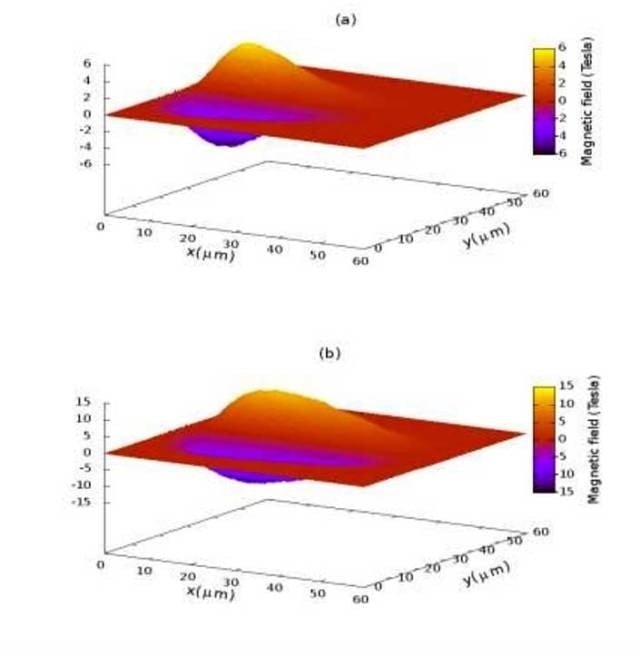Mar 23 2016
The Large Hadron Collider (LHC) is a huge particle accelerator, which played a key role in the detection of the elusive particle, Higgs boson. The LHC, buried beneath the Swiss-French border, requires a track extending 27 km for particle acceleration close to the velocity of light before the collision of the particles.
 This image shows the self-generated magnetic field strength of a symmetric laser pulse (a) and an asymmetric laser pulse (b), given the same laser strength and plasma density characteristics. The maximum magnitude of the magnetic field is about 15 Tesla for the asymmetric pulse, compared to 6 Tesla for the symmetric pulse. (credit: Gupta, et al/ JAP)
This image shows the self-generated magnetic field strength of a symmetric laser pulse (a) and an asymmetric laser pulse (b), given the same laser strength and plasma density characteristics. The maximum magnitude of the magnetic field is about 15 Tesla for the asymmetric pulse, compared to 6 Tesla for the symmetric pulse. (credit: Gupta, et al/ JAP)
However, laser wakefield accelerators are a type of particle accelerator requiring only a fraction of the distance of traditional accelerators like the LHC. As they can be mounted on a standard laboratory table, they are also known as benchtop accelerators. A new method has been proposed by a team of Indian and South Korean researchers to enhance the quality of the beam used in the laser wakefield accelerators.
As the size and cost of laser wakefied accelerators represent a tiny proportion compared to traditional accelerators, they could help to perform high-energy physics experiments in more laboratories and universities, and generate charged particles for medical treatments. The effectiveness of the devices could be improved by enhancing the beam quality.
The study results have been reported in AIP Publishing’s Journal of Applied Physics.
Groups of charged particles are accelerated by conventional particle accelerators using radio waves or electric fields. However, the principle of operation is different for laser wakefield accelerators. A pulse has been transmitted through a diffuse plasma by the laser in the laser wakefield accelerator. Plasma is a state of matter consisting of free electrons and positive ions. The waves in the plasma are excited by the laser pulse, creating an electric field called a laser wakefield. This electric field traps electrons and speeds them up to reach energy levels, upto the order of gigaelectronvolts.
In comparison, the LHC, the world’s most powerful particle accelerator, can accelerate particles to energy levels of teraelectronvolts (1000 gigaelectronvolts). The newly developed technique could help to trap more electrons in the wake of the laser pulse, according to the researchers. This enhances the quality of the laser beam used in the laser wakefield accelerators.
The results could help to develop better technology for future accelerators, said Devki Nandan Gupta, a member of the research team and a physicist at the University of Delhi in India. In addition to an electric field, a magnetic field can be generated by plasma-laser interactions. The propagation of a laser pulse through a plasma makes the electric field of the laser pulse push the surrounding electrons. The presence of a net electron current in the pulse would lead to the generation of a magnetic field.
Gupta and his collaborators used 2D computer simulations to analyze laser-plasma dynamics, and they discovered that a larger magnetic field would result due to variation in the plasma density and compression of the laser pulse at the front, which makes it asymmetric.
Our study might be helpful in improving the beam quality of the laser wakefield accelerators. The self-generated magnetic field bends the trajectory of the outgoing electrons towards the plasma wake, consequently the total number of trapped charge particles in the plasma wake increases and hence the total charge in the accelerated bunch in the laser wakefield acceleration increases.
Devki Nandan Gupta, Physicist, Univeristy of Delhi
Plasma-based accelerators need roughly 1000 times less distance when compared to standard particle accelerators to attain a comparable particle energy level. The technology still remains in the developmental stage. Some national laboratories and universities have built experimental plasma accelerators and the technology is continuously improving.
Gupta and his collaborators believe that their research could lead to the development of next-generation plasma accelerators.
The next step would be to justify these results in three-dimensional geometry. Of course, we may think to test these results experimentally in future as well.
Devki Nandan Gupta, Physicist, Univeristy of Delhi